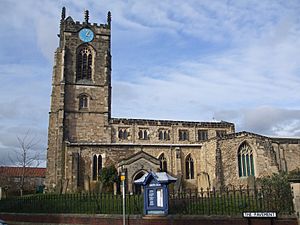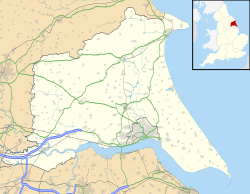Church of All Saints, Pocklington facts for kids
Quick facts for kids All Saints Church |
|
|---|---|
| Church of All Saints, Pocklington | |

All Saints' Church, Pocklington
|
|
| 53°55′50″N 0°46′47″W / 53.9306°N 0.7796°W | |
| OS grid reference | SE 80232 48974 |
| Country | England |
| Denomination | Church of England |
| Administration | |
| Parish | Pocklington and Owsthorpe and Kilnwick Percy |
| Benefice | Pocklington Wold |
| Deanery | South Wold |
| Archdeaconry | York |
| Diocese | Diocese of York |
All Saints' Church in Pocklington is a very old and important church in the East Riding of Yorkshire, England. It is part of the Church of England. People sometimes call it the Cathedral of the Wolds because it's so grand. This church is a special Grade I listed building, which means it's historically very important. Most of it was built between the 12th and 15th centuries.
Contents
History of All Saints' Church
Early Beginnings
It is thought that Saint Paulinus, a missionary, started the first Christian church in Pocklington. This happened around 627 AD. He was on his way to set up York Minster. A cross in the churchyard, called the Sotheby Cross, even has an old message saying "Paulinus here preached and celebrated AD627".
The church building has very old foundations from the Saxon times. You can still see some parts of the Norman church that was built later. However, most of the church you see today was built much later, from the late 1100s to the early 1400s.
Unique Church Clock
The church has a special clock that was made in 1841. It's unusual because it uses only one main part to both strike the hours and chime the quarter hours. This clock was fixed up in 2004. There's only one other church clock known to have a similar design, which is at St John's Church in Keswick, Cumbria.
Changes and Repairs in the 1800s
In the late 1800s, the church had a lot of big repairs and changes. Many of the beautiful stained glass windows you see today were put in then. The pulpit, which is where the priest stands to give sermons, also dates from this time. It has two carved pictures. One shows the story of the parable of the Good Samaritan, and the other shows St Peter healing a man.
Restoring the Church for the Future
In 2004, a special fundraising effort called the All Saints Heritage Appeal Fund began. It was also known as 'Reveal and Restore'. The goal was to raise £250,000. This money was needed to make the west end of the church better. They wanted to add more facilities, create extra space for more people, and show off some important historical parts of the building. The first part of this work has already been finished. The funds also helped fix crumbling stone on the outside of the church.
During the repairs in the 1890s, a message was put into a glass bottle. It also had a newspaper from that time. This bottle was buried under the base of the old Sotheby Cross. In 2005, during more repairs, the bottle was found by accident. The old message and newspaper were then re-buried in the same spot. A copy of the Pocklington Post newspaper from 2005 was added too.
Stories from the Past
The Flying Man of Pocklington
In 1733, a famous person known as the Flying Man of Pocklington, Thomas Pelling, tried to do something amazing. He attempted to travel along a rope stretched between the church and the Star Inn in the Market Square. Sadly, he fell to his death. He hit the church wall after a misunderstanding with the people working the windlass (a machine used to pull ropes). Thomas Pelling is buried where he fell, at the east end of the church. There is a plaque there to remember him.
The Sotheby Cross
In the churchyard, you can find the Sotheby Cross. This cross was made for or in memory of John Soteby, who was born in Pocklington in 1390. It dates back to the 15th century.
The cross was found buried in the churchyard in 1835. After that, it was kept inside the church for many years. In 2006, it was moved back to the churchyard. Its exact spot was found by looking at an old drawing from the 1880s. A stonemason named Matthias Garn made a new top part for the cross using special Tadcaster limestone.
The Sotheby family has a long history, going back to Roger of Lincoln, born in 1302. They came to Pocklington around 1380. One of John Soteby's family members, James Sotheby, was both the vicar of Pocklington and the headmaster of Pocklington School in the 1620s. A very famous part of the Sotheby family later moved to London. They gave their name to Sotheby's, which is a world-famous company that sells art and other valuable items at auctions.
All Saints' Church Today
All Saints' Church is still a very active place today. It holds many events and activities for the local community. It also has strong connections with Pocklington Church of England Infants' School. The church is part of a group of churches called the Benefice of Pocklington Wold. This group also includes churches in Burnby, Great Givendale, Hayton, Huggate, Millington, and Nunburnholme.
The current vicar, Reverend Dr Jacob Belder, started his role on September 22, 2020.
See also
- Grade I listed churches in the East Riding of Yorkshire
- History of Pocklington
- Pocklington School


